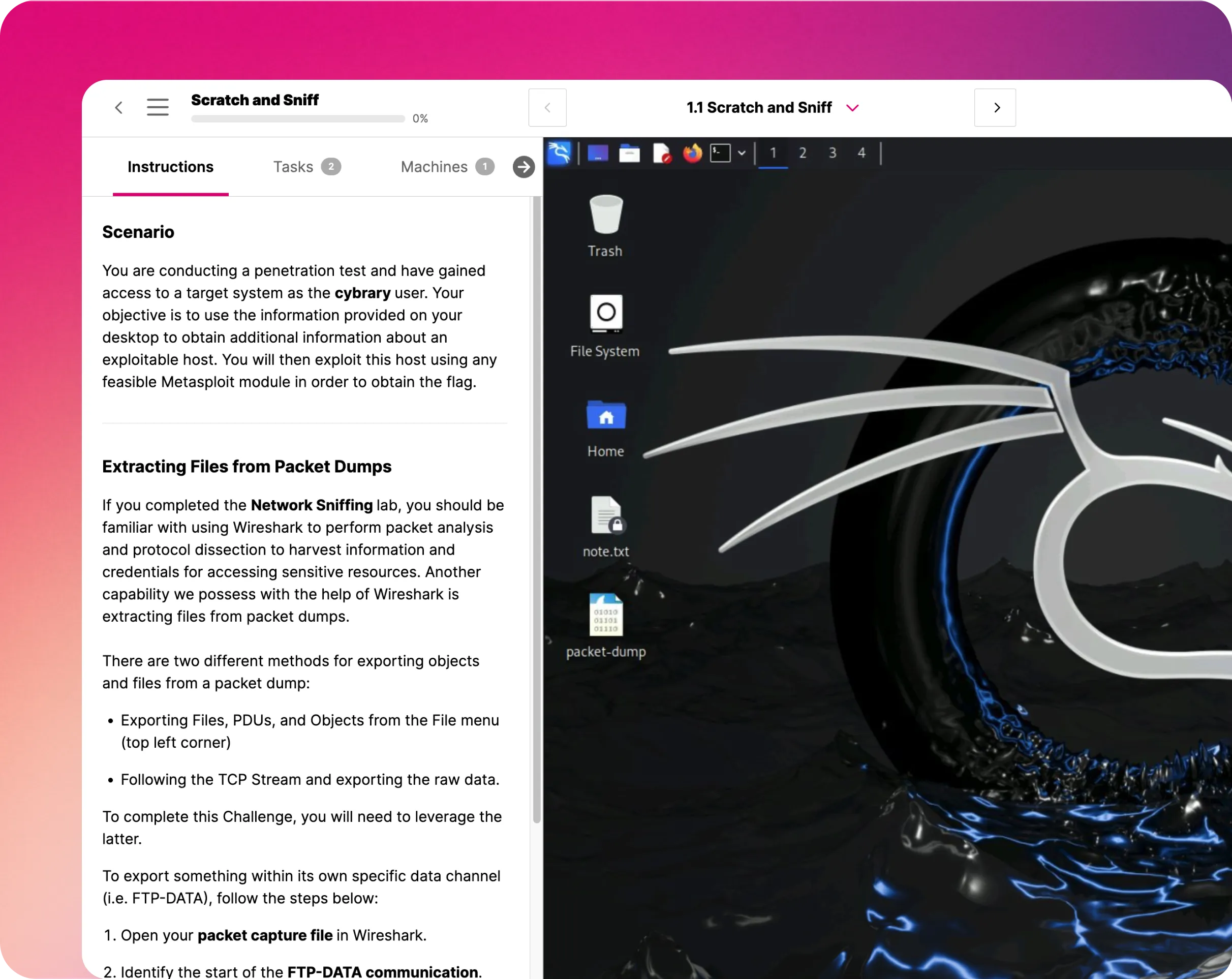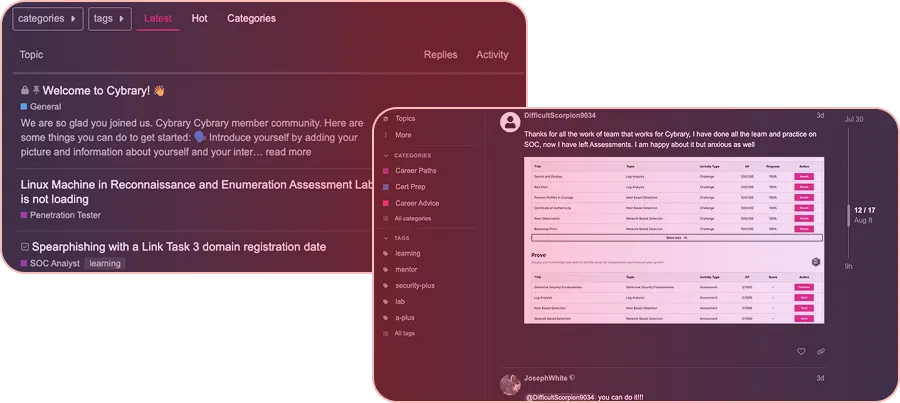CompTIA A+
The CompTIA A+ certification prep path will provide you with a comprehensive overview of the cybersecurity principles and security best practices needed to pass the A+ certification exams.

40
H
38
M
Beginner
7190
39
Learners at 96% of Fortune 1000 companies trust Cybrary
About this Path
CompTIA’s A+ certification reinforces and enhances your knowledge of everyday technology, hardware, and software in the workplace. This certification consists of two exams that learners must pass to achieve the A+ certification.
Core 1 focuses primarily on the hardware side of A+: configuring peripheral devices, repairing devices, and other elements that provide critical IT support. Core 2 focuses on the software side of A+: operating system support, software troubleshooting and more.
Skills you'll gain
Path Outline
Collection Outline
Coming Soon
The Leadership and Management Career Path is expected to release in Q2 of 2025. Sign up now to explore our other leadership courses and content.
Start Learning for FreeLearn
Learn core concepts and get hands-on with key skills.
A+ Core 1: Mobile Devices

This A+ Core 1: Mobile Devices course covers laptop hardware and display components, mobile device accessories, ports, connectivity and application.
A+ Core 1: Networking

This A+ Core 1: Networking Technology course will cover common networking hardware, wireless standards, and common network configuration concepts.
A+ Core 1: Hardware

This A+ Core 1: Hardware course will cover basic cable types, storage devices, and printers and multifunction devices.
In this A+ Core 1: Virtualization and Cloud Computing course you will learn about cloud computing concepts and client-side virtualization.
This A+ Core 1: Hardware and Network Troubleshooting course will cover motherboard, RAM, CPU, and power problems, mobile devices, and printers.
A+ Core 2: Operating Systems

In this course, you will learn about the Windows control panel, Windows settings, and Windows networking.
A+ Core 2: Security

In this course, you will learn about malware, social engineering and basic Windows OS security.
A+ Core 2: Software Troubleshooting

In this course, you will learn about Windows OS problems, malware removal, and mobile OS issues.
In this course, you will learn about documentation and support management, communication and professionalism, and scripting basics.
Practice
Exercise your problem-solving and creative thinking skills with security-centric puzzles
Network Reference Models

In this hands-on lab, you will learn about the OSI and TCP/IP Reference Models and how they are used to organize the communications standards used by computer networks. You will then explore the different layers of the two models using Wireshark and a PCAP file containing wireless network traffic.
VPN Basics

In this lab, you will learn the basics of Virtual Private Networks (VPNs). You will practice configuring a site-to-site IPsec VPN implementation using two pfSense firewall appliances.
IP Addressing Basics

In this hands-on lab, you will learn the basics of IP addressing. You will practice analyzing a TCP/IP network topology in the GNS3 network simulator using basic Linux commands.
Network Device Basics

In this hands-on lab, you will learn the basics of network devices. You will practice assessing and configuring a simple network topology in the GNS3 network simulator.
Linux CLI Basics

In this hands-on lab, you will learn the basics of the Linux Command Line Interface. You will learn and practice several common Linux commands.
Data Backup and Recovery Basics

In this hands-on lab, you will learn the basics of data backup and recovery, including different types of backups. You will practice using Windows Server Backup to create a data backup and recover files from a data backup.
Linux File System Basics

In this hands-on lab, you will learn the basics of the Linux file system. You will practice using the Linux CLI to navigate the Linux file system and explore important directories.
Access Control Basics

In this hands-on lab, you will learn the basics of access control, including different types of access control. You will practice using Windows Security Permissions and icacls to manage and verify and access control.
Windows File System Basics

In this hands-on lab, you will learn the basics of the Windows file system. You will practice using the File Explorer and the Windows CLI to navigate the Windows file system and explore important directories.
Windows Services

In this hands-on lab, you learn the basics of Windows Services. You will explore several key Windows Services using the Service Control Manager and PowerShell, and demonstrate the risks associated with unquoted service paths.
EDR Basics

In this hands-on lab, you will learn the basics of Endpoint Detection and Response tools. You will practice using the Wazuh EDR to install an agent on a Windows endpoint and detect simulated attacks aligned to the MITRE ATT&CK framework.
Antivirus Basics

In this hands-on lab, you will learn the basics of antivirus software. You will practice using Windows Defender Antivirus to detect and remove malware from a Windows system.
Network Troubleshooting Basics

In this hands-on lab, you will learn the basics of network troubleshooting. You will practice using common network troubleshooting tools and techniques to diagnose and resolve various network connectivity issues.
Active Directory Basics

In this hands-on lab, you will learn the basics of the Domain Controller and Active Directory features of the Windows Server operating system. You will practice configuring a Domain Controller and using Active Directory to manage users and groups.
Group Policy Basics

In this hands-on lab, you will learn the basics of Group Policy. You will explore Group Policy at the local and domain level, and use the Group Policy Management Console to create Organizational Units and link Group Policy Objects.
Firewall Basics

In this hands-on lab, you will learn the basics of firewalls, including core functionality and practical applications. You will practice writing, setting, and validating rules using the host-based iptables firewall on a Linux system.
BASH Scripting Basics

In this hands-on lab, you will learn the basics of BASH Scripting. You will practice using BASH to run simple one-liners, create arrays, and build re-usable scripts.
Python Basics

In this hands-on lab, you will learn the basics of Python. You will practice using several key Python concepts using the REPL interactive shell, as well as develop a simple script using VS Code.
PowerShell Basics

In this hands-on lab, you will learn the basics of PowerShell. You will practice using common cmdlets to navigate files and folders and gather system information. You will also use PowerShell to create scripts for automating simple tasks.
Prove
Assess your knowledge and skills to identify areas for improvement and measure your growth
CompTIA A+ Exam: Core 1 (220-1101)

Practice Test for the CompTIA A+ 220-1101 Exam. CompTIA A+ 220-1101 is the first of two exams required to obtain a CompTIA A+ certification.
Practice Test for the CompTIA A+ 220-1102 Exam. CompTIA A+ 220-1102 is the second of two exams required to obtain a CompTIA A+ certification.
Train Your Team
Cybrary’s expert-led cybersecurity courses help your team remediate skill gaps and get up-to-date on certifications. Utilize Cybrary to stay ahead of emerging threats and provide team members with clarity on how to learn, grow, and advance their careers within your organization.
Instructors
Instructors

Learn
Learn core concepts and get hands-on with key skills.

Practice
Exercise your problem-solving and creative thinking skills with security-centric puzzles

Prove
Assess your knowledge and skills to identify areas for improvement and measure your growth

Get Hands-on Learning
Put your skills to the test in virtual labs, challenges, and simulated environments.

Measure Your Progress
Track your skills development from lesson to lesson using the Cybrary Skills Tracker.

Connect with the Community
Connect with peers and mentors through our supportive community of cybersecurity professionals.
Success from Our Learners
Frequently Asked Questions
This certification prep path is designed for early career practitioners who are interested in earning their A+ certification.
This certification prep path is aligned with the CompTIA A+ 220-1101 (Core 1) and 220-1102 (Core 2) exams.
The CompTIA A+ certification is the industry standard for establishing a career in IT. A+ validates your expertise in several key IT areas, including troubleshooting, hardware, software, and network basics.
As one of the most widely recognized beginner IT credentials, A+ demonstrates to employers that you have the foundational skills required for an entry-level IT support role. It also provides a strong foundation for further advancement into specialized IT and cybersecurity roles.
The CompTIA A+ certification requires learners to pass two exams containing multiple choice, drag-and-drop, and performance-based questions. The first exam covers topics related to mobile devices, networking technology, hardware, virtualization and cloud computing. The second exam covers operating systems, security, software and operational procedures.
Cybrary’s CompTIA A+ certification prep path covers all relevant topics and includes two practice tests that will ensure you’re ready for the official certification exams.
CompTIA A+ prepares you for general, entry-level IT positions, such as technical support specialist, field service technician, desktop support administrator, IT support technician, and more.
A+ also provides a great foundation of basic IT knowledge for those interested in pursuing a more specialized role in IT or cybersecurity. Many A+ certificate holders go on to obtain further training or certifications in areas like networking, security, or cloud computing.















